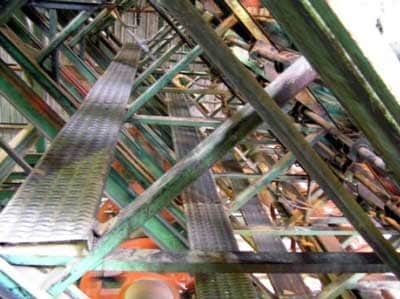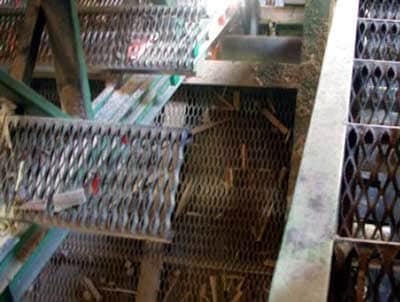Temporary Mill Worker Dies in Fall from Tower Catwalk
Oregon Case Report: 05OR018
October 10, 2006
Summary
On June 23, 2005, a 43-year-old temporary worker at a lumber planing mill, operating a tower conveyor, fell 17 ft. off a catwalk in the tower, and died 2 days later. While operating the planer, the temporary worker observed broken pieces of 2x4s beginning to jam up the flow of lumber. Following standard procedure, he stopped the conveyor and stepped onto one of the catwalks that traverse the interior of the metal-beam structure in order to reach the jam. He picked up a broken 2×4 and stepped backward on the catwalk to the platform; then walked out on the catwalk a second time to retrieve another long 2×4, and backed out, dragging the board. At the end of the catwalk, he missed his footing and fell to the concrete floor below, striking his head on another machine in his fall. Emergency responders arrived within a few minutes and transported the victim to the local hospital, where he underwent immediate surgery. He later died in the hospital.

|
| Catwalks in the tower planer provided access to areas where lumber occasionally jammed in the conveyor system. |
Recommendations
- Guardrails must be installed on regularly used access walkways that are 4 ft or more above the ground. If guardrails are not feasible, alternative fall protection must be employed.
- Training in safe work procedures should be provided to all workers, including temporary workers.
- Employers should conduct hazard surveys and follow through with corrective action.
Introduction
On June 23, 2005, a 43-yr-old temporary worker at a lumber planing mill, operating a tower conveyor, fell 17 ft. off a catwalk in the tower, and died 2 days later. OR-FACE received notification of the incident on June 27. An OR-FACE investigator visited the site and conducted interviews. Additional information was obtained from Oregon OSHA and medical examiner reports.
The employer was an Oregon sawmill company, founded in 1954, operating a planing mill, a stud mill, and a sawmill, as well as a timber company and a lumber wholesale company. The mill operations employed 310 nonunion workers in two shifts. The planing mill employed 24 workers. On both shifts at the planing mill, the tower operator was a temporary worker. Two coworkers were in the vicinity at the time of this incident.
The temporary labor contractor provided about 1,100 temporary workers to Oregon industry, with three temporary workers employed at the sawmill company at the time of this incident. Agency staff performed a general customer site evaluation prior to worker placement. The agency also provided a general safety orientation to workers that included a basic overview of construction safety training, an audiovisual orientation program, a worker safety manual, and a written quiz. The employer was responsible for providing workers with site-specific orientation, job and safety training, and personal protective equipment.
The tower operator was hired by the temporary labor contractor on June 3, 2003. He worked at the sawmill company’s stud mill for 17 days over a several-month period in 2004. He was hired by the employer again about 5 weeks before the incident, on May 17, and was assigned to the planer tower on swing shift. He received on-the-job training during one shift. He was reported to be a good tower operator, without any safety violations, and apparently in good health.
This incident was the only fatality for the sawmill company in its 51-year history, and the first planer tower injury in 30 years. The mills had a comprehensive written safety program, a safety committee composed of both labor and management, and regular safety meetings. A planing mill worker was on the safety committee. Job safety analyses were completed for critical jobs, including the planer tower operator. The human resources manager served as the safety director. Mill supervisors were responsible for on-the-job training and overseeing worker adherence to mill safety requirements, such as lockout and fall protection. Temporary workers were provided on-the-job training, but were not included in the formal safety training program.
Tower operators were responsible for clearing the flow of lumber when a jam occurred, which required walking on a catwalk into the interior of the structure, and possibly the use of a chainsaw. The job safety analysis for the tower operator’s job identified noise and hand/foot/eye injuries as potential hazards. The required personal protection equipment included leather gloves, leather boots above the ankles, safety glasses, and hearing protection. The potential for falls was not identified in the safety analysis, and tower operators were not provided fall protection.
Investigation
The planing mill used a 30-year-old tower conveyor system: a large metal-beam structure about 1.5 stories high. The tower conveyor mechanically moved lengths of cut lumber up a 30 ft incline into sorting trays by length and grade of lumber. The tower was electrically powered with a chain, belt, and sprocket wheel system. A metal stairway was located on one side of the tower to provide access to various levels of the conveyor system.
The tower operator’s job was to observe lumber flow, straighten lumber in trays, and unjam lumber, which involved the removal of broken pieces that blocked the normal flow of boards. Two platforms, accessed by the side stairway, were used to observe the flow of boards. Stop buttons were located on each platform to shut down the conveyor when a jam occurred.
Originally, the tower operator climbed the tower’s metal support trusses to remove lumber jams. Eight years ago, five metal-grip strut catwalks, each 12 in. wide by 35 ft long, were bolted to the support beams, so workers could access the interior of the machine from the stairway. The available lengths of strut material left a 2 ft. gap between the stairway and the catwalk.

|
| While backing off the catwalk pulling a board, the tower operator fell when he missed his footing at the end of the narrow catwalk. |
To clear a lumber jam, the tower operator stopped the conveyor, then stepped from the stairway over the gap onto one of the catwalks, while also bending under a metal crossbeam. The operator crawled along the catwalk, freed the lumber jam from the conveyor, and pulled the board out while crawling backward on the catwalk. This procedure could occur several times daily. Occasionally, the operator needed to use a chainsaw to cut the jammed lumber.
On the day of the incident, the planer was running long 2×4 boards. The swing shift started at 5:30 p.m. At 12:10 a.m., the tower operator hit the emergency stop button, shutting down the conveyor and the trim saws below. The operator climbed onto an upper catwalk to retrieve a jammed 2×4, and then returned to his station. One of the trim-saw operators observed another board crossed up and called on the intercom to the tower operator, who then crawled out onto the catwalk and retrieved the second board. He walked backward in a crouched position, pulling the board, and then stood up at the end of the catwalk. A trim-saw operator then saw him step backward into the 2 ft gap between the catwalk and the end of the stairway. The tower operator fell 17 ft to the concrete floor below, hitting his head on a piece of machinery during the fall. While backing off the catwalk pulling a board, the tower operator fell when he missed his footing at the end of the narrow catwalk.
Another trim-saw operator who witnessed the fall immediately called the supervisor on the intercom for emergency assistance. Emergency responders arrived within a few minutes and transported the victim to the local hospital, where he underwent immediate surgery. The victim died in the hospital 2 days later.
Cause of Death
Blunt head and chest injuries.
Recommendations/Discussion
Recommendation #1: Guardrails must be installed on regularly used access walkways that are 4 ft or more above the ground. If guardrails are not feasible, alternative fall protection must be employed.
The unguarded, narrow walkway in this incident was the primary risk factor, exacerbated by difficult access and the 2 ft gap at the end of the catwalk. Guardrails are required on all open sides of any regularly used access walkway that is situated 4 ft or more above the adjacent floor or ground level (29 CFR 1910.23(c)). Special-purpose walkways may omit the guardrail on one side, provided the width of the runway is at least 18 in. wide. In this incident, the catwalks were only 12 in. wide and the installation of guardrails was not feasible through the interior crossbeams of the machine. The employer has since modified the stairway and landings to allow better access to the catwalks, and has installed wire cables along the length of each catwalk as part of a new tower fall-protection system. Workers accessing the catwalks are provided and required to wear a body harness with lanyard attached to the cable. (Leg protection for chainsaw use has also been added to the tower operator’s personal protection equipment.)
Recommendation #2. Effective training in safe work procedures must be provided to all workers, including temporary workers.
Employers should ensure that all workers, including temporary workers, are properly instructed and supervised in safe work processes related to their job duties, including operation of machinery, and use of tools and equipment. A temporary labor contractor, as illustrated in this incident, is responsible for general employee competence and orientation. The direct employer of a temporary worker is responsible for specific job training and safety. The employer in this incident now provides the same safety training received by regular employees to temporary employees.
Recommendation #3. Employers should conduct a thorough hazard survey to identify all significant workplace hazards, and follow through with corrective action.
A thorough hazard survey of the workplace and a job safety analysis can identify hazards and unsafe work practices. A hazard survey is best performed regularly by a competent person, such as the safety manager. Corrective actions should be set with a schedule for completion. A job safety analysis provides additional information by tracking each step in a work process, identifying safe work procedures and necessary personal protection equipment. Employee safety training should incorporate the results of the job safety analysis.
References
- Center for Research on Occupational and Environmental Toxicology. CROETweb.com “Fall protection” Online resource: http://www.croetweb.com/external icon
- National Institute for Occupational Safety and Health. (2000). Worker deaths by falls [Pub 2000-116]. Available online: https://www.cdc.gov/niosh/docs/2000-116/ (Link updated 4/13/2015)
- National Institute for Occupational Safety and Health. (n.d.). Fatal falls from elevation investigation reports. National and state FACE reports available online: https://wwwn.cdc.gov/NIOSH-FACE/Default.cshtml?state=ALL&Incident_Year=ALL&Category2=0007&Submit=Submit (in-house) and https://wwwn.cdc.gov/NIOSH-FACE/Default.cshtml?Category=0007&Category2=ALL&Submit=Submit (state based) (links updated 04/8/2015)
- Occupational Health and Safety Administration. (n.d.). Fall protection. Online resource: https://www.osha.gov/SLTC/fallprotection/external icon
- Oregon OSHA. (n.d.). Fall protection. Online resource: http://www.cbs.state.or.us/external/osha/subjects/fall_protection.htmlexternal icon
- Oregon OSHA.(2006). Fall protection for the construction industry [ Pub 440-2824]. Available online: http://www.cbs.state.or.us/external/osha/pdf/pubs/2824.pdfpdf iconexternal icon
Oregon FACE Program
To contact Oregon State FACE program personnel regarding State-based FACE reports, please use information listed on the Contact Sheet on the NIOSH FACE web site. Please contact In-house FACE program personnel regarding In-house FACE reports and to gain assistance when State-FACE program personnel cannot be reached.
CROET at OHSU performs OR-FACE investigations through a cooperative agreement with the National Institute for Occupational Safety and Health (NIOSH), Division of Safety Research. The goal of these evaluations is to prevent fatal work injuries in the future by studying the work environment, the worker, the task, the tools, the fatal energy exchange, and the role of management in controlling how these factors interact.
Oregon FACE reports are for information, research, or occupational injury control only. Safety and health practices may have changed since the investigation was conducted and the report was completed. Persons needing regulatory compliance information should consult the appropriate regulatory agency.
 external icon
external icon
